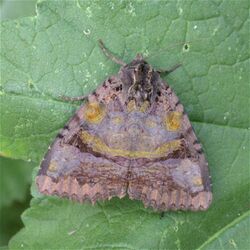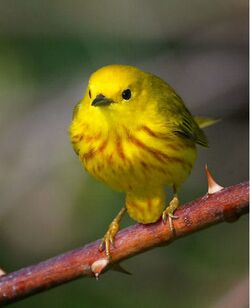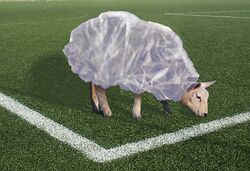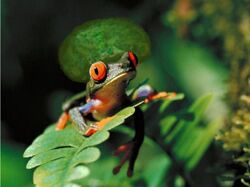Unnatural Selection
“In all the long and illustrious history of natural selection, I ain’t never seen shit like this.”
Natural selection, as any heathen knows, is the preservation of useful traits within a species. When the evolutionary process, through a continuous series of trial and error experiments spanning billions of years, produces a minor mutation that is deemed valuable, like colourful plumage, prehensile tails or cameltoe, that trait is retained and promulgated throughout the species in a beautiful, unending dance of life. That, or your imaginary friend created everything just last week.
But what of the failed missteps in the evolutionary ladder, the unnatural selections? Some species seem to retain undesirable traits that lead to their inevitable extinction- such as the Dodo, a bird so ridiculous looking you couldn’t help but shoot it, or the manatee, whose peaceful existence will soon fall to our outboard motors. A Beluga has also made an unnatural selection of making their caviar so delicious that we must spear the living daylights out of them.
The following creatures are so bizarre and wholly unbelievable that their very existence is a bitch-slap unto intelligent design’s crude, superstitious face. Much like the dinosaurs or the lesser known marshmallosaurs, these strange critters will soon be ancient history. But not before we get our sterilized mitts on ‘em, dissect ‘em, study ‘em and then eat the remains for supper... all in the name of science, of course.
Van Gogh Moth[edit]
The Van Gogh Moth (Locus Bipolis), a North Netherlandonian insect, is a curious specimen and the center of a polarizing entomological debate to determine whether this particular moth is preternaturally gifted or suffering from a series of severe mental neuroses. In fact, entomologists joke that perhaps Vincent van Gogh was named after the moth and not vice versa, clearly showing that entomologists possess no observable sense of humour. The first notable feature is the markings on the wings, which are said to resemble van Gogh’s The Starry Night or The Night Café or The Lady of the Night Got My Earlobe or some other steaming bucket of Post-impressionistic crap (artistically speaking, everything past Blue Dog is lost to us).
Although most moths are seemingly attracted to light and want to have dirty sex with it, the Van Gogh Moth remains unaffected by the naughty yet oh-so-pleasurable allure of the ebb and flow of electromagnetic radiation and instead finds itself, much like its namesake, possessed of a singular predilection for absinthe. This, of course, makes for some peculiar flight patterns within the species, and global economists note that drunken-moth-midair-collisions are the third greatest Dutch export, following useless windmill memorabilia and venereal disease.
These reckless crashes are also responsible for the next synchronic peculiarity, namely the moth’s lack of a left antenna. Believed to be the result of a hapless accident in the species distant past, it is unclear why this lopsided feature has been retained throughout the generations as it seems to hold no clear purpose and has in fact negatively impacted the moth’s already crippled GPS navigational system. This asymmetrical appendage, when coupled with the constant absinthe abuse, has led to the cause of the species near extinction and the last commonality with the insect’s namesake- a Van Gogh Moth, upon entering the airspace above a cornfield, will invariably fly kamikaze-style into the dust below, thus negating its beautiful, miserable existence.
Big-balled Warbler[edit]
The Big-balled Warbler (Vermivora Sactasticae) is a small songbird inhabiting El Bosque Rizado de Pelo, a coniferous forest region in Mexico.
These birds are distinguished by their bright yellow colouring, a lack of wing bars, a small pointed bill and really humongous testicles. This bird can be easily identified by it's call when attempting to land, a distinctive "ooh-ooh-ooh-ooh-ouch". Members of this species measure 13.5 cm and weigh 30g, 15g of which are its balls, the only external testes within the avian class. It is unknown how such a mutation initially occurred, but it can be said that the result is a bird who is stubbornly territorial, quick to act and react in a violent manner and possesses the lowest basso profondo within the songbird suborder.
The oversized generative glands of the Big-balled warbler are used to attract the female of the species who, curiously enough, possesses a sac of her own, though hers contain the ovaries and is also duller in colour. When she enters the male’s territory, the female warbler is treated to the male’s deep call, which is often mistaken for a bullfrog or William S. Burroughs. The male then "shakes his sac" in a dance that can only be described as the single most disturbing sight within the animal kingdom. If the dance is found enticing, the male and female will build a nest together out of cigarette butts and used fabric softener sheets where the female will lay her eggs in sets of two or seven, depending on who you ask.
Unfortunately for the Big-balled warbler, the size and weight of its extremely large balls limits its flight to short bursts and as such this warbler is more apt to fall victim to predatory strikes and is also unable to migrate away from the especially fertile Mexicans whose ever-encroaching civilization threatens the bird’s natural habitat. Warbler Balls are also prized in several Mexican villages as the ultimate fiesta appetizer, further threatening their population.
Plastic Sheep[edit]
Plastic Sheep (Crepundia Ovis) are any of a number of sheep whose coat is comprised of condensation polymers instead of the more commonly found wool, giving this quadruped a uniquely synthetic-looking sheen. These polymers are then sheered from the sheep and set to a variety of uses, most notably polyester shirts, soda bottles and fiberglass underwear. The sheep’s diet is primarily AstroTurf, which is broken down within the sheep’s body and defecated in the form of green and blue miniature toy militias.
The Plastic sheep population was nearly decimated in the 1970's when copious amounts of cocaine gave people the idea that polyester was the most fashionable substance on Earth and many of the creatures fell to the Quaalude-addled hands of overworked sheep shearers unsteadily wielding their high-powered clippers. The species is still endangered due to the rapidly declining popularity of professional sporting events and the simultaneous rising popularity of tailgating which has led to the demolition of many stadiums and arenas, the main sources of AstroTurf, to make way for larger parking lots. The larger lots, in turn, strengthen the numbers within the automobile herds, which are the Plastic sheep’s only natural predator. These automobiles, upon their death, will begin to decompose and their belts and tires will fertilize the AstroTurf, thus completing the circle of life, which moves us all.
Afro-American Tree Frog[edit]
The Agalychnis Gravatus, commonly known as the Afro-American Tree Frog is a native to densely inhabited rainforests throughout Central and South America.
The afro from where it takes its name is actually a form of moss which develops on the frog’s head due to the damp conditions within the rainforest and it works as a biogenic filtering system for this species. Toxins breathed through the frog’s skin are absorbed by the moss, which then uses the chemical reaction to attract insects, this carnivore’s main food source.
Known for brevity’s sake simply as green frogs, these amphibious creatures are locked in an eternal struggle with the more heavily populated Albino frogs (Agalychnis Niveus) who have dominated the forests for generations. Even though the two are almost genetically identical, Albino frogs have exhibited an unwillingness to share the canopy equally with their green counterparts in the past, although this behavior seems to be gradually giving way to a more cooperative symbiotic relationship, although the evolutionary process in this case has taken an inordinate amount of time.
Forced to adapt to these oppressive conditions Afro-American tree frogs have become more physically capable, able to leap greater distance and adhere to a more expansive variety of surfaces due to stronger toe pads. On average the male’s tongues are 12 cm longer than those of their pale cousins, allowing them to successfully catch a greater amount of food, ranging from flies and beetles, although some green frogs have been known to consume an entire chicken head when food supplies are scarce. The female green frogs are generally more shapely than female Albinos, a trait found more physically pleasing by nine out of ten newts. Both the male and female of the species possess an extremely beautiful, rhythmic call which is often poorly imitated by the Albino population. These increased abilities have led to what is scientifically referred to as Jungle Fever, in which white frogs and green frogs recover their lost roots and instinctively reunite and reproduce together, genetically strengthening the collective species chance of survival. Of course, none of this should be seen as analogous to the social or cultural situations pertaining to any other living creature, as it is merely an explanation of frogs. Seriously.
Giant One-eyed Yak[edit]

The elusive Giant One-eyed Yak (Ingemino Entendri) inhabits America’s Tri-State Region- New York (America’s left teat), New Jersey (America’s armpit) and Pennsylvania (America’s superfluous third nipple), though it has been spotted several times in Florida (it’s a peninsula- figure it out). The Great Yak as it’s often called, is estimated to measure 30m high and 60m long, unprecedented in the yak community. It is, in fact, the only one of its kind and many speculate that it is a ghost, a miracle or even a form of higher bovinity; regardless of semantics, this creature is almost certainly eternal. Nomadic in lifestyle, many of its habits remain a mystery to mere mortals but a few facts may be ascertained if we try to advance our way of thinking.
This yak has one eye. Several theories abound that the one eye is really made up of a million smaller eyes or that the one eye is not actually an eye at all but rather a frisbee, but there is no reason to listen to the inklings of entomologists and potheads, respectively. Other than sight, this one eye shoots an amazing white ray of light whenever the yak is severely agitated. It is unknown if this is used as a warning or is just a release of energy surpluses, but it can result in some damaging effects. Elton John was said to have performed his free concert in Philadelphia during the summer of 2005 merely because of his love for Giant One-eyed Yak.
The immense size, although intimidating to most other creatures, seems to entice an unusually high amount of female humans who, either drawn in by pheromones or a process of mesmerization, shed their fears and inhibitions. Feeling the lure of the beast, the women gather around, sometimes in droves, and caress it playfully, exciting the Great Yak who then fires the white ray of light leaving big explosions in its wake. Being especially virile, it may fire its eye-beam six or seven times daily, depending on the quality and persistence of the female gropers.
Sometimes the immense beast grows weary of the constant adulation and other times male humans, jealous of the attention their women lavish upon Giant Yak, banish it and at these times it will disappear for months or years at a time to an undisclosed location. Though its whereabouts and actions are unknown during these reclusive periods, it is speculated that Giant One-eyed Yak enjoys passing the time with basket weaving, kayaking and Sudoku. But no matter how long it is gone, the Great Yak will always come back.
“In the wiki of the blind the one eyed yak is king.”





